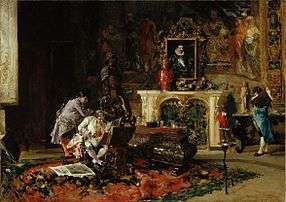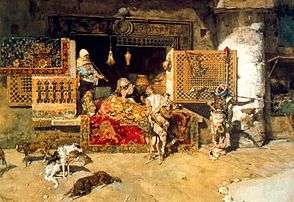Marià Fortuny
| Marià Fortuny | |
|---|---|
 Self portrait by Marià Fortuny (1863-73) | |
| Born |
June 11, 1838 Reus |
| Died |
November 21, 1874 (aged 36) Rome |
| Nationality | Spanish |
| Known for | Painting |
| Movement | Romanticism |
Marià Fortuny i Marsal (complete name Marià Josep Maria Bernat Fortuny i Marsal, pronounced [məˈɾja ʒuˈzɛp məˈria bərˈnat fuɾˈtuɲ i mərˈsal]; in Spanish: Mariano José María Bernardo Fortuny y Marsal; June 11, 1838 – November 21, 1874), known more simply as Marià Fortuny or Mariano Fortuny, was the leading Catalan painter of his day, with an international reputation. His brief career encompassed works on a variety of subjects common in the art of the period, including the Romantic fascination with Orientalist themes, historicist genre painting, military painting of Spanish colonial expansion, as well as a prescient loosening of brush-stroke and color.
Biography
He was born in Reus, a town near Tarragona, in Catalonia, Spain. His father died when Marià was an infant, and his mother by the time he was 12. Thus, Marià was raised by his grandfather, a cabinet-maker who taught him to make wax figurines. At the age of 9, at a public competition in his town, a local painter, teacher and patron, Domènec Soberano i Mestres, encouraged further study. At the age of 14 he moved to Barcelona with his grandfather. The sculptor Domènec Talarn secured him a pension allowing him to attend the Academy of Barcelona (La Llotja school of art). There he studied for four years under Claudi Lorenzale and Pau Milà i Fontanals, and in March 1857 he gained a scholarship that entitled him to two years of studies in Rome starting in 1858. There he studied drawing and grand manner styles, together with Josep Armet i Portanell, at the Academia Giggi.

In 1859, he was called by the Government of the Province of Barcelona (Diputació de Barcelona) to depict the campaigns of the Spanish-Moroccan War. He went to Morocco from February to April of that year, making sketches of landscapes and battles, which he showed in Madrid and Barcelona when he returned. These would later serve him as preliminary sketches for his monumental piece, The Battle of Tetuan (La batalla de Tetuan, 1862–64, Museu Nacional d'Art de Catalunya).
Since the days of Velázquez, there had been a tradition in Spain (and throughout Europe) of memorializing battles and victories in paint. On the basis of his experiences, Fortuny was commissioned by the Council of the Province of Barcelona (Diputació de Barcelona) to paint a large canvas diorama of the capture of the camps of Muley-el-Abbas and Muley-el-Hamed by the Spanish army. He began his composition of The battle of Tetuan on a canvas 15 metres long; but, though he worked on it off and on during the next decade, it was never finished.
The greater influence of this travel on Fortuny was his subsequent fascination with the exotic themes of the world of Morocco, painting both individuals and imagined court scenes. He visited Paris in 1868 and shortly afterwards married Cecilia de Madrazo, the daughter of Federico de Madrazo, who would become curator of the Prado Museum in Madrid. Together, they had a son, Mariano Fortuny y Madrazo, who became a well-known fashion and tapestry designer. Another visit to Paris in 1870 was followed by a two years' stay at Granada, but then he returned to Rome, where he died somewhat suddenly on November 21, 1874 from an attack of tertian ague, or malaria, contracted while painting in the open air at Naples and Portici in the summer of 1874. One of his pupils was Attilio Simonetti.
Legacy
Fortuny paintings are colorful, with a vivacious iridescent brushstroke that at times recalls the softness of Rococo painting but also anticipates impressionist brushwork. Richard Muther states:
his marvellously sensitive eye … discerned the stalls of Moorish carpet-sellers, with little figures swarming, and the rich display of woven stuffs of the East; the weary attitude of old Arabs sitting in the sun; the sombre, brooding faces of strange snake-charmers and magicians. This is no Parisian East…every one here speaks Arabic.
Fortuny often painted scenes where contemporary life had still not shaken off the epaulets and decorations of ancient traditions such as the ‘’Burial of a matador’’ and couples signing marriage contracts (La Vicaria). Each has the dazzle of bric-a-brac[1] ornament, but as in his painting of the Judgement of the model, that painterly decorative air of Rococo and Romanticism was fading into academicism and left to confront the naked reality of the represented object. He inherited Goya's eye for the paradox of ceremony and reality.
Gallery
 The Print Collector, 1863
The Print Collector, 1863
 The Tapestry Seller, 1870
The Tapestry Seller, 1870.jpg) The Odalisque, 1861
The Odalisque, 1861 The Slaying of the Abencerrages, c.1870
The Slaying of the Abencerrages, c.1870 Carmen Bastian, c.1871
Carmen Bastian, c.1871
See also
- Palazzo Fortuny in Venice, Italy
- List of Marià Fortuny's Paintings (in Catalan)
Bibliography
- Entry for Marià Fortuny i Marsal in Gran Encicplopèdia Catalana (in Catalan)
- Charles Davillier, Fortuny, sa vie, son œuvre, sa correspondance, etc. (Paris, 1875)
- Charles Yriarte, Fortuny (Artistes célèbres series) (Paris, 1889).
References
| Wikimedia Commons has media related to Marià Fortuny. |
- ↑ Huneker, James.
- Charles Yriarte and Richard Muther, ed. (1908). Masters in Art: A Series of Illustrated Monographs (Part 110 Volume 10). Congress Street, Boston; Digitized Googlebooks: Bates and Guild company.
- Muther, Richard (1897). The History of Modern Painting (Volume 3). E.P. Dutton and Company, New York. Googlebooks digitized June 26, 2007.: Bates and Guild company. pp. 308–315.
- James, Huneker (1922). Promenades of an Impressionist. New York; Digitized Googlebooks: Charles Scribner's Sons. p. 128.
 This article incorporates text from a publication now in the public domain: Chisholm, Hugh, ed. (1911). "Fortuny, Mariano Jose Maria Bernardo". Encyclopædia Britannica (11th ed.). Cambridge University Press.
This article incorporates text from a publication now in the public domain: Chisholm, Hugh, ed. (1911). "Fortuny, Mariano Jose Maria Bernardo". Encyclopædia Britannica (11th ed.). Cambridge University Press.- 3 Painting(s) by or after Marià Fortuny at the Art UK site